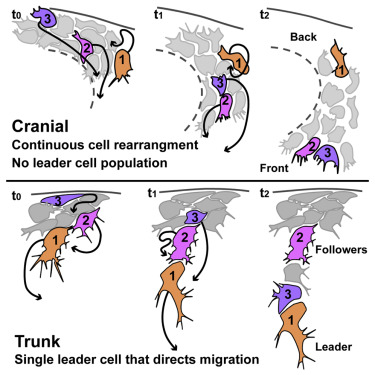
Citation
J. Richardson, A. Gauert, L.B. Montecinos, L. Fanlo, Z.M. Alhashem, R. Assar, E. Marti, A. Kabla, S. Härtel, C. Linker
Cell Reports, 15:2076–2088 (2016)
Abstract
Abstract
Collective cell migration is fundamental for life and a hallmark of cancer. Neural crest (NC) cells migrate collectively, but the mechanisms governing this process remain controversial. Previous analyses in Xenopus indicate that cranial NC (CNC) cells are a homogeneous population relying on cell-cell interactions for directional migration, while chick embryo analyses suggest a heterogeneous population with leader cells instructing directionality. Our data in chick and zebrafish embryos show that CNC cells do not require leader cells for migration and all cells present similar migratory capacities. In contrast, laser ablation of trunk NC (TNC) cells shows that leader cells direct movement and cell-cell contacts are required for migration. Moreover, leader and follower identities are acquired before the initiation of migration and remain fixed thereafter. Thus, two distinct mechanisms establish the directionality of CNC cells and TNC cells. This implies the existence of multiple molecular mechanisms for collective cell migration.
Figure sample


